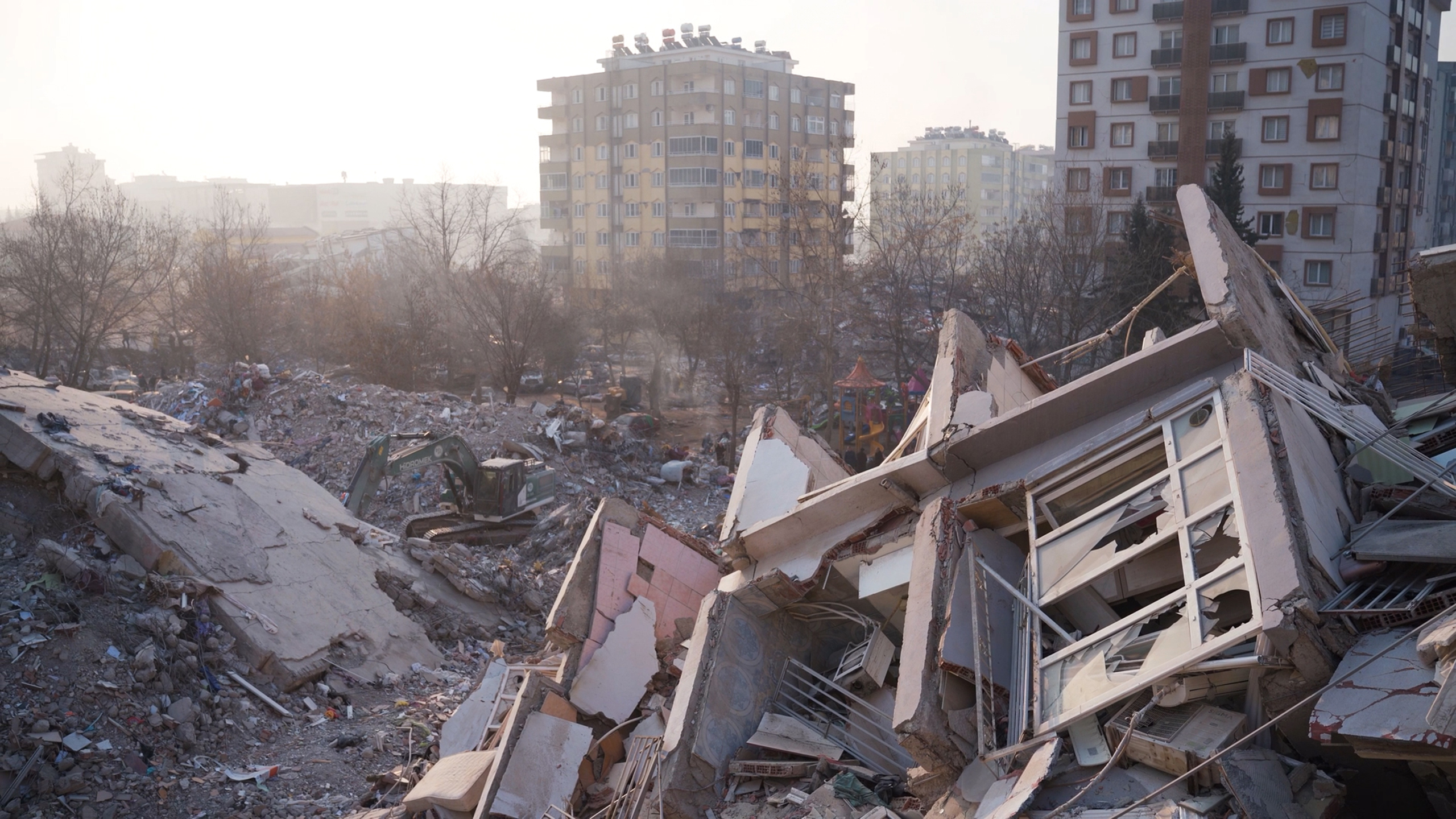
Earthquakes, thunderstorms, floods:
Natural disaster figures for the first half of 2023
07/27/2023
Reinsurance
properties.trackTitle
properties.trackSubtitle
- Overall losses of US$ 110bn – above the 10-year average
- Insured losses according to provisional estimates amount to US$ 43bn, also much higher than the 10-year average
- Devastating earthquake in Turkey and Syria responsible for highest overall losses
- Series of extreme thunderstorms, including tornadoes and hail, in the USA account for roughly one third of overall global losses
- Climate change and El Niño drive record temperatures

The earthquake disaster in Turkey and Syria illustrates the importance of robust and safe buildings. The primary aim must be to save lives. The next step is to reduce losses in such catastrophes. We also need to adapt to handle the consequences of global warming in the form of more frequent or more severe weather disasters much more effectively – by employing appropriate construction methods, selecting sites that can withstand future impacts and by having insurance to cover the immediate financial consequences. This is starkly illustrated by the loss figures for the first half of 2023.
Natural disasters in figures:
The first half of 2023 is a continuation of the recent run of years with high losses. While the overall losses of US$ 110bn were lower than those in the first half of 2022 (US$ 120bn), they were still well above the average for the last ten years (US$ 98bn, inflation-adjusted). The same is true for the insured losses of US$ 43bn (previous year: US$ 47bn; ten-year average for half-year losses: US$ 34bn).
Less than 40% of overall losses in the first half of the year were insured – evidence of the large insurance gap that persists in many countries for multiple natural hazards. Insurers bore around 35% of worldwide losses in terms of the average half-year losses in the period 2013–2022.
What were the costliest natural disasters in the first half of the year?
The earthquake in Turkey and Syria was by far the most devastating natural disaster in the six months of the year. On 6 February, a series of tremors struck southeastern Turkey close to the border with Syria. The two strongest tremors had magnitudes of 7.8 and 7.5 respectively and were the strongest earthquakes in Turkey in decades. A very large number of buildings, roads and bridges were destroyed. Around 58,000 people lost their lives. As a result, the global number of victims of natural disasters in the first half of the year (some 62,000) was higher than it had been since 2010. Overall losses from the earthquake in both countries are estimated at around US$ 40bn, with Syria accounting for roughly US$ 5bn.
Despite the establishment of the Turkish Catastrophe Insurance Pool (TCIP), which provides compulsory insurance for residential buildings in Turkey and now has insurance penetration of more than 50%, the insured portion of overall losses totalling around US$ 5bn remained small. The sum insured under the TCIP is limited to TL 640,000 per residential unit (equivalent to approximately US$ 34,000 at the time of the earthquake). Commercial enterprises are not included in the pool. Similarly, infrastructure is generally not insured. Particularly in a country as exposed to earthquakes as Turkey, it would be both desirable and practicable to have a wider spread of insurance cover, to ensure that those affected – governments included – can recover more rapidly from the financial losses.
Extremely high losses from severe thunderstorms in the USA
In the USA in the first half of the year, multiple rounds of severe thunderstorms, accompanied by destructive tornadoes and hail, caused losses to spike. Overall losses from these storms came to more than US$ 35bn, of which more than US$ 25bn was insured. Losses of this magnitude from severe thunderstorms in the USA now seem to be normal occurrences, rather than outliers. After adjustment for inflation, higher first-half thunderstorm losses have only occurred once before in the USA USA (in 2011, with US$ 46bn in overall losses and US$ 29bn in insured losses).
The costliest single event of the year so far was a series of thunderstorms in mid-June, which affected large parts of Texas. Severe squalls and hailstones measuring up to twelve centimetres in diameter – almost twice the size of a tennis ball – caused the most serious damage. More than 50 tornadoes were recorded, some of which were rated F3 on the Enhanced Fujita Scale, with wind speeds in excess of 218 km/h. The overall loss for this outbreak is estimated at around US$ 8.4bn, of which approximately US$ 7bn was insured.
Most researchers assume that climate change is facilitating the formation of severe thunderstorms with tornadoes and hail, since the continuing warming is resulting in greater evaporation and, particularly at ground level, in increased humidity. This increases the potential for thunderstorms to form. Loss statistics for thunderstorms in North America and Europe are also trending upwards, even after adjustment for the increase in values from economic development.
Climate change and El Niño – 2023 could be the warmest year ever
“The effects of climate change are having a stronger and stronger impact on our lives. The first half of 2023 was characterised by record temperatures in many regions of the world, very high water temperatures in various ocean basins, droughts in parts of Europe, and severe wildfires in northeastern Canada,” said Ernst Rauch, Chief Climate and Geo Scientist at Munich Re. The global average temperature for June was the warmest ever recorded, up by more than 1.2°C compared to pre-industrial times.
“As in 2016, the natural climate phenomenon El Niño is playing a role in 2023. It is characterised by a temperature swing in the Pacific that influences extreme weather in many regions of the world and causes temperatures to temporarily rise further. All the same, research on global temperature trends is unequivocal: rising water and air temperatures worldwide are mainly driven by climate change, in turn causing more weather-related natural disasters and financial losses,” Rauch added.
Hurricane activity in the North Atlantic generally decreases during an El Niño phase. However, the exceptionally high water temperature in the main areas of hurricane formation, with values that are 1–2°C above the average, make it more likely that a greater number of storms will form in the season’s main phase starting in August. This makes it difficult to predict what the current hurricane season will be like.
Regional overview
North America – severe thunderstorms with tornadoes and hail are driving up losses
As usual, extreme severe thunderstorms in the USA in the first half of the year, in conjunction with other disasters, accounted for North America’s high share in worldwide losses. Overall losses were US$ 42bn, of which approximately US$ 32bn was insured – a reflection of the region’s high insurance penetration for thunderstorm losses, motor own damage in particular.
Extreme wildfires in Nova Scotia in northeastern Canada attracted global attention. Massive fires blazed for several weeks in regions that were relatively sparsely populated. This helped keep direct losses within reasonable limits. However, ash and clouds of smoke spread across large parts of the eastern USA and darkened the sky over cities such as New York. There were no major relevant losses for insurers.
Europe – high proportion of losses from Turkey earthquake
As a result of the earthquake disaster in Turkey, the proportion of losses in Europe in the first half of 2023 was exceptionally high. Of roughly US$ 59bn (€48bn) in overall losses, only some US$ 7bn (€6.7bn) was insured.
As well as the earthquake in Turkey, severe floods in northeastern Italy and neighbouring countries resulted in extremely high losses. Particularly affected was the Emilia-Romagna region in northern Italy, where after two years of drought, the area experienced several episodes of extreme rainfall in May. As many as 23 rivers burst their banks. An analysis of the event concluded that there was a 1-in-200-year probability of such prolonged heavy rainfall in the affected region.
Due to the high level of urbanisation, the floods had a serious impact: overall losses came to roughly US$ 10bn (€9bn). However, only US$ 1.1bn (€1bn) of these losses were insured due to the fact that, as in many other countries, flood risk is not covered under standard building insurance. As in other European countries, a higher insurance penetration could ensure that those affected are not left to shoulder the losses themselves, or be left dependent on outside assistance. In addition, an appropriately designed policy could increase the incentive to take loss reduction measures.
Asia-Pacific: New Zealand hit by several disasters
In the Asia-Pacific region, natural disasters resulted in overall losses of approximately US$ 7bn, of which roughly US$ 3bn was insured. In New Zealand, high losses were caused by flooding following heavy rainfall, as well as Cyclone Gabrielle making landfall. Assets worth some US$ 4.3bn were destroyed, of which around US$ 2.9bn was insured.
Large areas of China and Southeast Asia suffered recurrent heat waves between March and June, breaking many local and seasonal records. Tianjin, a city with over 10 million inhabitants, measured a record high of 41.4ºC. For Asia as a whole, the months of February to June were the fourth warmest on record, as was June alone.
Cyclone Freddy claimed a large number of lives in Mozambique and other countries in southeastern Africa. Freddy was probably the longest active tropical cyclone since records began. It formed at the start of February to the north of Australia and then traversed the entire Indian Ocean. After making landfall in Madagascar, it meandered back and forth between Madagascar and Mozambique. The southeastern African country was then impacted a second time by the cyclone. Some 860 people lost their lives. Overall losses in Mozambique and neighbouring countries came to approximately US$ 1.5bn. Due to the very low insurance penetration in low-income countries, however, only a negligible portion of the losses was insured.
Further information
Munich Re is one of the world’s leading providers of reinsurance, primary insurance and insurance-related risk solutions. The group consists of the reinsurance and ERGO business segments, as well as the asset management company MEAG. Munich Re is globally active and operates in all lines of the insurance business. Since it was founded in 1880, Munich Re has been known for its unrivalled risk-related expertise and its sound financial position. It offers customers financial protection when faced with exceptional levels of damage – from the 1906 San Francisco earthquake through Hurricane Ian in 2022. Munich Re possesses outstanding innovative strength, which enables it to also provide coverage for extraordinary risks such as rocket launches, renewable energies or cyberattacks. The company is playing a key role in driving forward the digital transformation of the insurance industry, and in doing so has further expanded its ability to assess risks and the range of services that it offers. Its tailor-made solutions and close proximity to its customers make Munich Re one of the world’s most sought-after risk partners for businesses, institutions, and private individuals.
Disclaimer
Munich Re’s NatCatSERVICE collects information from governmental agencies, scientific institutes, associations, the insurance industry, the media and other publicly available sources in order to analyse nat cat losses. NatCatSERVICE applies Munich Re’s comprehensive in-house nat cat expertise and market data from the worldwide insurance markets to its analyses. Munich Re assumes no guarantees as to the accuracy of this data, which is collected as of specific dates and can also change at any time. The information may not be used as the basis for any decision without prior professional advice and careful contextual analysis. Munich Re is not liable for damages arising from any decisions that third parties may take on the basis of this information.
This media release contains forward-looking statements that are based on current assumptions and forecasts of the management of Munich Re. Known and unknown risks, uncertainties and other factors could lead to material differences between the forward-looking statements given here and the actual development, in particular the results, financial situation and performance of our Company. The Company assumes no liability to update these forward-looking statements or to make them conform to future events or developments.
For Media inquiries please contact
/Straub_Stefan.jpg)
/Rakette-Axel_gold.jpg/_jcr_content/renditions/crop-1x1-400.jpg./crop-1x1-400.jpg)

/Faith_Thoms.jpg)
/Ashleigh-Lockhart.jpg/_jcr_content/renditions/crop-1x1-400.jpg./crop-1x1-400.jpg)